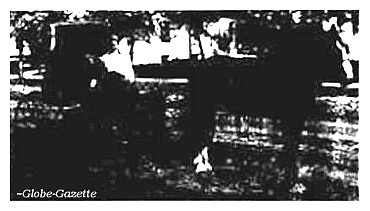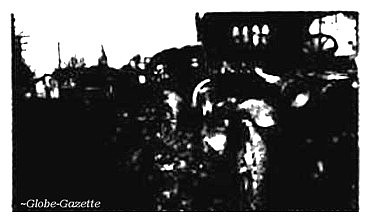


Cerro Gordo County Iowa
Part of the IaGenWeb Project
|
The Globe Gazette 

* * * * * * * * * * * * * * * * * * * * * * * * *

This Rock Island locomotive of the early 1870s and an 1877 diner will be displayed by the Rock Island railroad on the tracks immediately south of the Mason City freight station, 328 S. Federal, for the Centennial. This equipment will be of particular interest as part of the transportation day exhibit on Wednesday, when all types of transport used over the past century will be shown. It will be impossible, however, to have this locomotive and car in the parade, but visitors will be welcome.
Sloughs Dreaded by Earlier Day Travelers [Page 30] Many North Iowa motorists can remember when a long drive required two sets of chains, when road maps were practically unheard of and filling stations were few and far between. Spring rains made the roadways difficult because of the mud but there was a road. The oft used word of the pioneer travelers - "sloughs" - was being dropped from the vocabulary. There was a time, however, when Iowa sloughs ranked with mosquitos as a principal annoyance on the prairies. The accounts of many of the early settlers in Mason City and environs tells of the perilous journey across the prairie with an ever present dread of sloughs. One of the famous sloughs of the early days - and one not encountered by local settlers - was in Calhoun County, where Purgatory Creek now flows underneath concrete bridges. In 1859 the editor of a Sioux City newspaper declared of "Purgatory Slough": "What a name! And oh! what a slough! we hear those exclaim who have been so unfortunate as to be caught in it. We heard one individual say that it took four yoke of oxen to pull his light buggy through this slough. The bottom of it has never yet been found, and it is thought by some that it has fallen out, leaving nothing there but black miry mud, a contest with which it is though must at least equal the supposed torments of Purgatory - hence the name."
The "Skunk Bottoms," an Iowa pioneer recalls, referred to the early swamplands along the Skunk River which were "known and dreaded by people from Maine to California." A party headed for the Colorado gold rush in 1859 reached the Skunk Bottoms on April 10, and "found them as bad as expected and that was bad enough." "We had to double teams for over a mile wagons down to the axletrees all the way," the traveler recorded, "raining all the while." Fifteen years earlier, in 1844, when the 1st Dragoons of the U.S. Army crossed what is now Humboldt County, a diarist noted that the soldiers struck "a succession of the most terrible slues we encountered and crossed." Every dragoon in the expedition from Fort Des Moines was engaged in pulling the wagons through the sloughs. "In consequence," the diary-keeper noted, "but 12 miles were made though in the saddle more or less for 12 hours." When a group of emigrants from Wisconsin passed through central Iowa on their way to California in 1863 a member of their party declared the sloughs in the Iowa River bottoms were the most troublesome. In one slough a tired horse refused to work. "I had to get out in mud and water knee-deep," he noted, "but as the horse saw me get the string out to use on her she started and pulled the whole load out."

Before the automobile, the horse and buggy were a prominent part of the scene. This picture, taken in 1905, shows Mr. and Mrs. Charles C. Barret, parents of Mrs. W. O. Barnard and of George C. and Lloyd R. Barrett, with their horse, Kit. The picture was taken in front of the residence at 1223 N. Federal.
An incident involving a slough in Boone County had a tragic aftermath in 1872. A public road passed near a farmer's land, and travelers bypassed a slough which made the road impassable by driving over the farmer's fence and through his field. The damage to the land must have been great for the owner finally erected a heavy rail fence to stopp the trampling of his crops. But the next morning found a wagon-driver taking his team across the field, past the remains of the fence. The owner became enraged in the altercation that followed and the traveler was killed. Although sloughs posed a problem for our pioneers, few hardy travelers were deterred by the prospects of a day spent with men and animals wallowing in the mud. Modern highways and drainage methods ended the slough "menace" and alos closed a muddy chapter in the history of transporation of Iowa.

When the first cross-country trails were marked by far-sighted highway enthusiasts, road were mostly unimproved with here and there stretches of gravel. This pictures shows the Interstate Trail, first marked north and south highway through Mason city, as it appeared at Manly in 1915.
Photographs courtesy of Globe-Gazette
|
Return to Mason City Centennial Index Page Return to History Index Page Return to Cerro Gordo Home Page